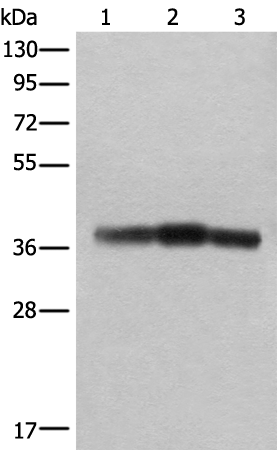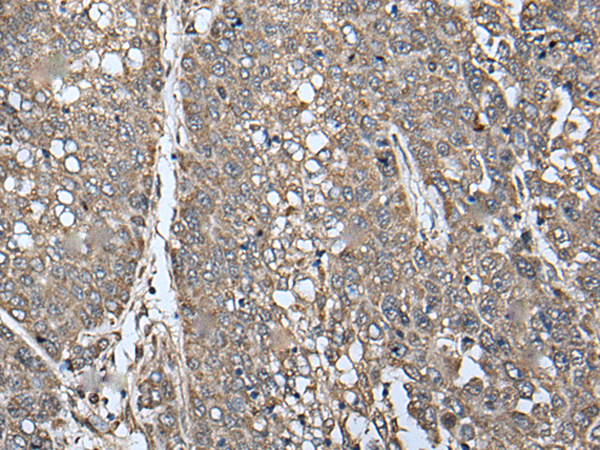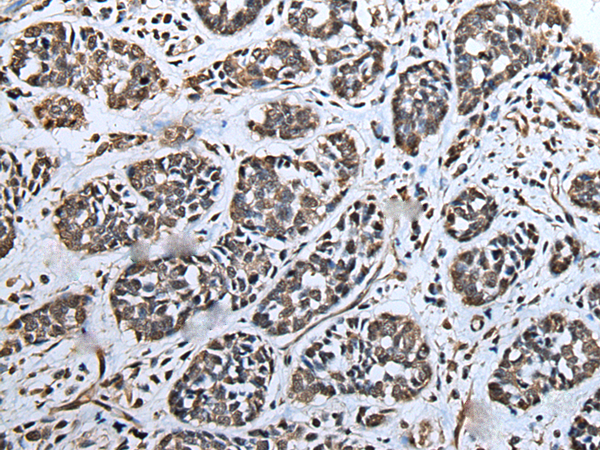


| WB | 咨询技术 | Human,Mouse,Rat |
| IF | 咨询技术 | Human,Mouse,Rat |
| IHC | 1/50-1/300 | Human,Mouse,Rat |
| ICC | 技术咨询 | Human,Mouse,Rat |
| FCM | 咨询技术 | Human,Mouse,Rat |
| Elisa | 1/5000-1/10000 | Human,Mouse,Rat |
| Aliases | AFDC1; FNP001; THORASE |
| WB Predicted band size | 41 kDa |
| Host/Isotype | Rabbit IgG |
| Antibody Type | Primary antibody |
| Storage | Store at 4°C short term. Aliquot and store at -20°C long term. Avoid freeze/thaw cycles. |
| Species Reactivity | Human, Mouse, Rat |
| Immunogen | Fusion protein of human ATAD1 |
| Formulation | Purified antibody in PBS with 0.05% sodium azide and 50% glycerol. |
+ +
以下是关于ATAD1抗体的3篇参考文献及其摘要概括:
---
1. **文献名称**:*ATPase family AAA domain-containing protein 1 (ATAD1) regulates mitochondrial fragmentation and neuronal survival*
**作者**:Chen et al.
**摘要**:该研究通过免疫印迹(Western blot)和免疫荧光技术,利用ATAD1抗体证实了其在调控线粒体分裂中的作用。实验表明,ATAD1缺失导致线粒体过度碎片化,并诱发神经元凋亡,提示其在线粒体动态平衡中的关键功能。
---
2. **文献名称**:*Thorase (ATAD1) modulates AMPA receptor recycling through its ATPase activity*
**作者**:Zhang et al.
**摘要**:研究利用ATAD1特异性抗体在小鼠脑组织中检测Thorase蛋白表达,发现其通过水解ATP调控AMPA受体的内吞与再循环。敲除ATAD1后,突触后受体稳定性受损,提示其在突触可塑性中的重要作用。
---
3. **文献名称**:*ATAD1 as a novel player in protein quality control: Insights from antibody-based subcellular localization*
**作者**:Wang et al.
**摘要**:通过免疫共聚焦显微镜和免疫沉淀技术,该文献揭示了ATAD1抗体在追踪蛋白降解途径中的应用。研究发现ATAD1与泛素-蛋白酶体系统相互作用,参与错误折叠蛋白的清除,为神经退行性疾病机制提供了新视角。
---
以上研究均通过ATAD1抗体探索了该蛋白的生物学功能,涵盖线粒体动力学、突触调控及蛋白质量控制等领域。
The ATAD1 antibody is a crucial tool for studying the ATPase family AAA domain-containing protein 1 (ATAD1), also known as Thorase. ATAD1 is a mitochondrial membrane-associated AAA+ ATPase that plays a key role in regulating mitochondrial dynamics and protein homeostasis. It is involved in the disassembly of mitochondrial membrane protein complexes, particularly mediating the removal of misfolded or excess proteins, such as the AMPA receptor subunit GluA1 in neurons. This function links ATAD1 to neuroprotection and neurodegenerative disorders like Alzheimer’s disease and Parkinson’s disease.
ATAD1 antibodies are widely used in research to detect and quantify ATAD1 expression via techniques such as Western blotting, immunohistochemistry, and immunoprecipitation. They help investigate ATAD1’s interaction with substrates, its ATPase activity, and its role in mitochondrial quality control. Studies using these antibodies have revealed ATAD1’s involvement in preventing neuronal excitotoxicity by regulating glutamate receptor turnover. Knockout mouse models and cell-based assays, supported by ATAD1 antibodies, highlight its essential role in maintaining mitochondrial integrity and cellular viability. Commercially available ATAD1 antibodies are typically validated for specificity using knockout controls or siRNA-mediated knockdown. Research utilizing these tools continues to explore ATAD1’s broader implications in metabolic disorders, cancer, and aging-related pathologies.
×